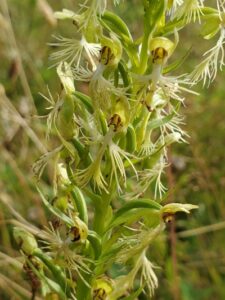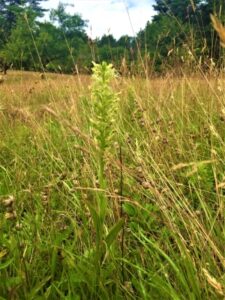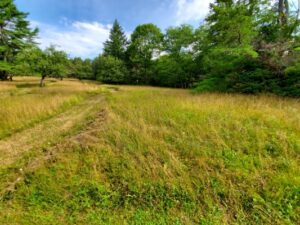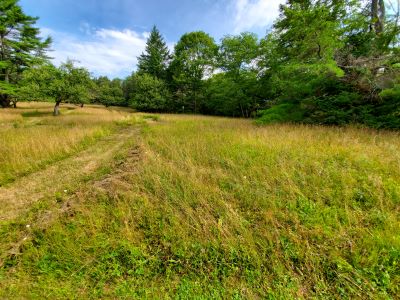August 3: On Finding a Rare Flower

Green fringed orchid in bloom
I was walking along one of the field trails at Oak Point Farm a few days ago when I was stopped in my tracks by a plant. I hike the trails regularly, and enjoy the waves of wildflowers throughout the growing season, greeting each emerging plant like an old friend who has returned for a visit. The small delicate flowers of spring transition to the lanky flowers of midsummer, then the hearty flowers of fall, each special in their own way and easy to recognize after years of hiking past them. So when I saw a solitary flower on the edge of the trail, unlike all of the familiar ones I just walked past, I put on the brakes.
The flower that caught my attention is very unassuming at first glance. It is not the tallest in the field and not the shortest either, so it easily melts into the crowd of grasses and goldenrods. Its girth is noticeable though, wider than other wildflowers in its vicinity. It was in bloom, but its delicate flowers weren’t showy from a distance and the colors were muted whites and greens. It was when I got on my hands and knees and looked a little closer that I discovered many exquisite blossoms, lacy, delicate, and very flashy.

A closer look at the orchid
I took a picture. Then I took many more pictures from different angles and distances. I had an idea of what I was looking at, but sent the photos to some botanist friends and convened with coworkers to verify its identification. Fast forward and the plant was visited by several experts and marked off in hopes of preventing it from being trampled. A closer examination of the field found 3 more flower specimens of the same species. So what was this exciting plant growing at Oak Point Farm? Everyone concurred that we were looking at a relatively rare Green Fringed Orchid (Platanthera lacera).
Most folks are familiar with the showy pink lady’s slipper that grace our forest floors in late spring, but Maine is home to several species of orchids that vary in size, appearance, and habitat. The green fringed orchid grows in moist meadows like the one I found it in, but can also be seen in bogs, swampy woodlands, and even along roadsides and riverbanks. It is more likely to appear in degraded areas then many other orchards and tolerates seasonal mowing, such as had been done at the spot I saw it growing.

The fields at Oak Point Farm, can you spot the orchid in the foreground?
Its flowers are greenish in color, so the green fringed orchid really doesn’t stand out from its background. What is noticeable is its deeply fringed lower lip. The flowers are primarily pollinated by moths, including Noctuid moths and Sphinx moths, which have been observed sucking nectar from the flowers. The moths visit the older flowers near the bottom of orchid first and then work their way up towards the younger flowers at the top, in a clever undertaking that insures they don’t miss any food. Sometimes the orchid itself becomes a gourmet meal to browsing mammals such as deer, rabbit, and cattle.
I visited the green fringed orchid recently and saw that its flowers have faded and the leaves have started to brown. The fields surrounding it have shifted to a new wave of wildflower species as the calendar turns to late summer. I read that the green fringed orchid appears irregularly, and that some years they will not bloom. Despite this, I am hopeful that when next summer rolls around I will once again see my new old friend in all its subtle and peculiar beauty.





